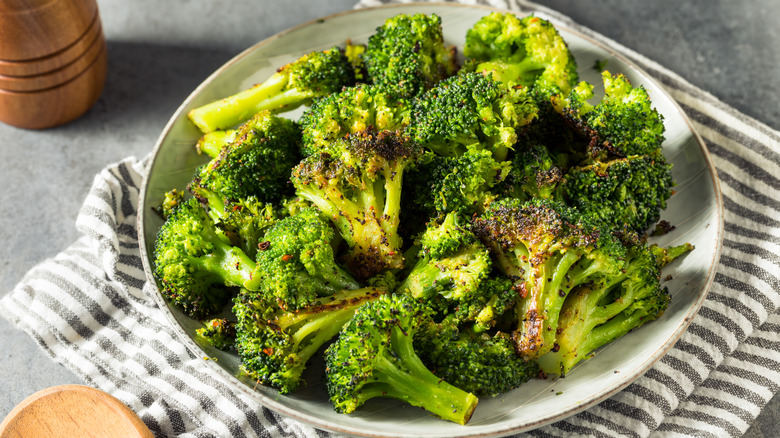For Top-Tier Roasted Broccoli, Don't Skimp On Oil Or Salt
When many people hear the word broccoli, it conjures up memories of sitting at the table as a kid refusing to eat the green florets. It's a strongly-flavored vegetable, and a commonly disliked one. But like most foods, when prepared properly, broccoli can offer an entirely new taste profile from the one you previously filed in your memory bank.
Love it or previously hated it, broccoli is at its best when roasted with plenty of flavorful oil and a generous amount of salt. Each of these ingredients influences the final taste, texture, and appearance of roasted broccoli, so it's important to know the how and why behind their use. Then there are the different types of oils and salts to consider. Overall though, roasting broccoli is one of the easiest things you can make in the kitchen, and the results leave you with a satisfying food you can eat as a side dish or add to a variety of casseroles, pastas, and grains.
The power of quality ingredients
The type of oil you choose for your roasted broccoli impacts the quality of the dish. Consider the smoke point before tossing oil on your broccoli and sliding into a hot oven. A generous coating of the right oil will caramelize the surface and brown the edges to a slight crisp. Since the oven temperature range for roasted broccoli and other vegetables is between 400 to 425 degrees Fahrenheit, skip low smoke point options like walnut and flax oils. Next, consider the flavor of the oil you choose. While taste is subjective, popular options for roasted broccoli include flavorful olive oil, as well as more neutrally-flavored avocado, grapeseed, canola, or safflower oils.
When it comes to types of salts, consider textures and flavors for your roasted broccoli. Reserve the fine table salt for baking and top your roasted broccoli with a coarse grind, medium grind, or flaked salts instead. While it might seem surprising, larger salt granules are less salty in flavor than fine salt varieties. Rely on Himalayan, kosher, or one of the endless types of sea salt to mellow the strong, bitter profile of the broccoli and bring out balanced flavors. Sprinkle some salt before roasting, then salt to taste before serving. Try flavored salts such as smoked, chipotle, or lemon for a bit of additional pizzazz.
Broccoli alternatives and enhancements
If you want to start with a milder flavor and work your way up to broccoli, try out another member of the brassica family. For example, roasted cauliflower or broccolini also benefit from a heavy pour of oil and grind of salt. Similarly, explore the lesser-known broccoli relative called romanesco. This succulent-looking plant with its chartreuse color and spiky florets will add some intrigue to your plate.
Whether you're making broccoli or delving into the world of roasted romanesco, try adding other ingredients to the dish. A drizzle of lemon after roasting will brighten the flavor profile while the addition of Parmigiano Reggiano near the end of the cooking time delivers a nutty essence. In fact, just about any cheese makes a nice addition to roasted broccoli, including mozzarella, cheddar, ricotta, and even a bold blue cheese.
You can also dress up roasted broccoli by topping with shaved almonds, toasted garlic, freshly ground pepper, or a drizzle of balsamic vinegar when the tray comes out of the oven. Making roasted broccoli is really more a technique than a recipe, so have fun with it. However you decide to go about it, just remember to start with a generous coating of olive oil, and don't skimp on the salt!


